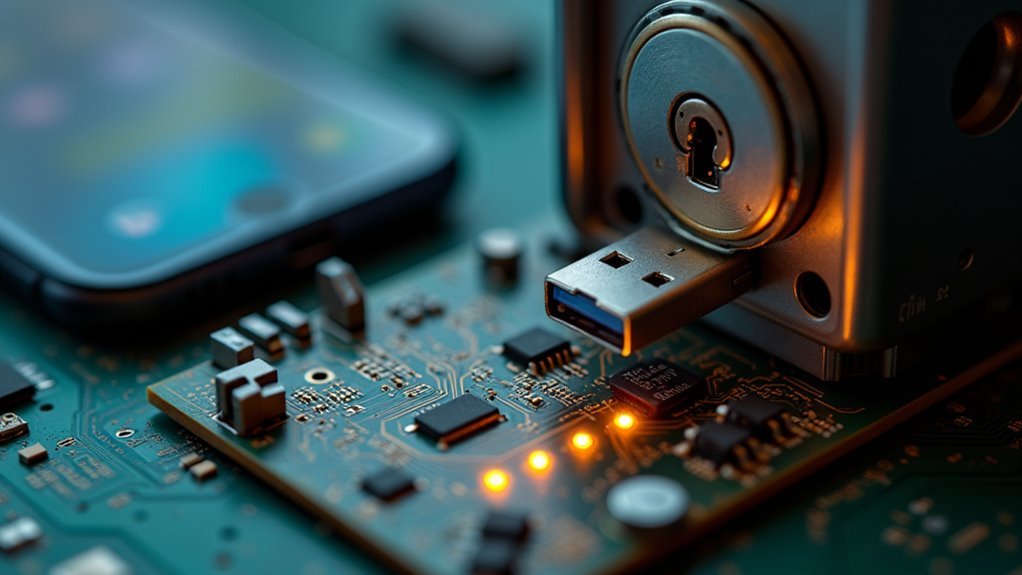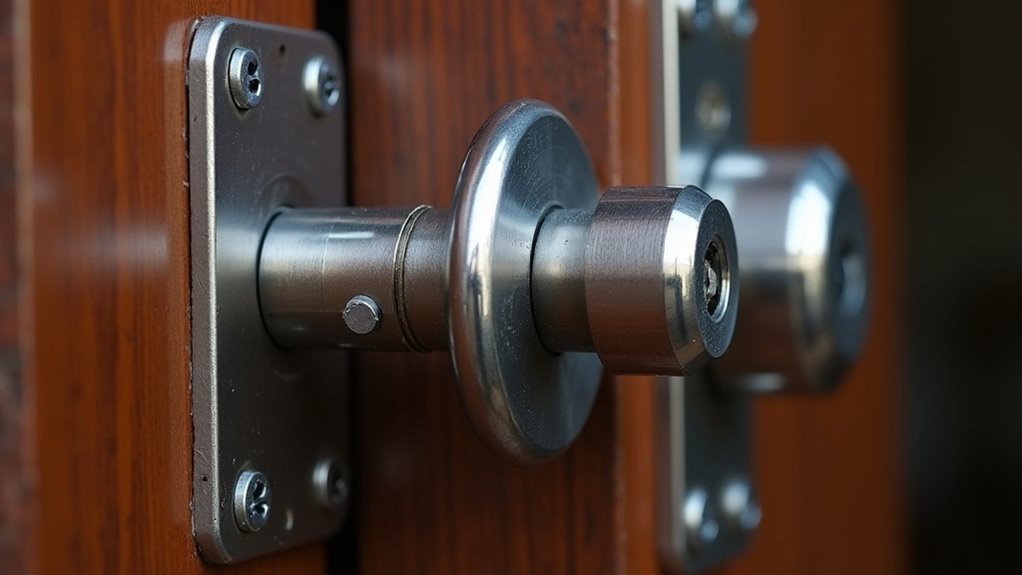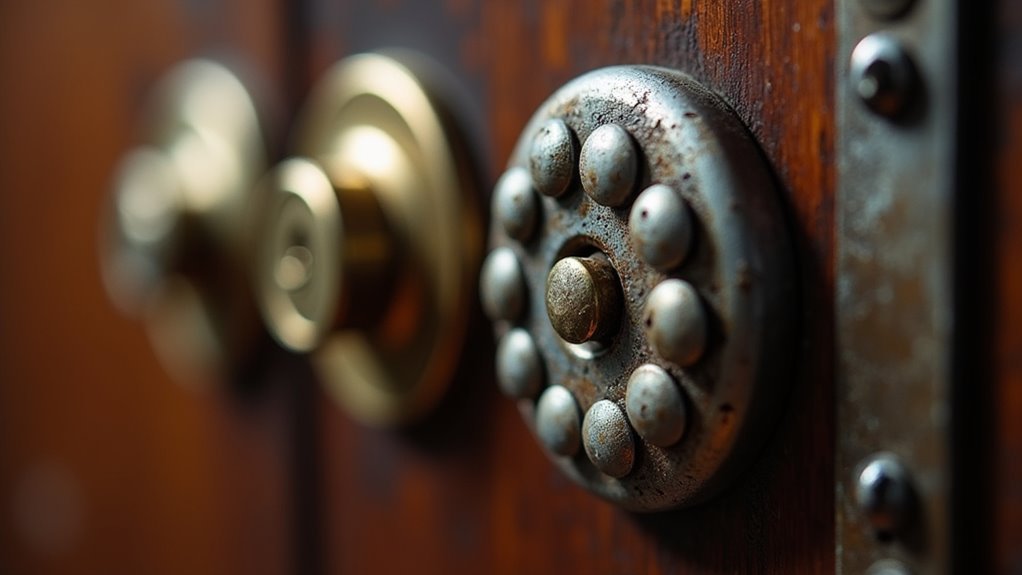You’ve probably heard about smart locks being hacked or traditional deadbolts failing when you least expect it. Your home’s first line of defense shouldn’t be your weakest link, yet most people don’t realize their lock systems have critical vulnerabilities that criminals actively exploit. Whether you’re using digital keypads, smartphone-controlled locks, or conventional hardware, there are seven specific security flaws that could be compromising your safety right now.
Regular Firmware Updates and Security Patches

When manufacturers release firmware updates for your smart lock system, you’re getting essential security patches that directly address vulnerabilities hackers could exploit.
These regular firmware updates act as your primary defense against unauthorized access attempts. Your lock manufacturer issues these critical updates to resolve specific flaws discovered through security research and user reports.
Firmware updates serve as your first line of defense, patching critical security vulnerabilities before hackers can exploit them.
You should enable automatic updates whenever possible to guarantee the latest security measures are applied immediately.
Don’t wait – periodically check for available updates from your lock manufacturer to stay protected against newly discovered threats.
These updates don’t just enhance security; they also improve your lock’s performance and introduce beneficial new features that make your system more reliable and user-friendly.
Strong Password Implementation and Two-Factor Authentication
Beyond maintaining updated firmware, your smart lock’s security depends heavily on implementing robust password protocols and multi-factor authentication.
Strong passwords serve as your first defense against unauthorized access and security breaches, while two-factor authentication provides enhanced security by blocking 99.9% of automated attacks.
Essential password security practices include:
- Creating passwords with 12+ characters combining uppercase, lowercase, numbers, and special characters
- Enabling two-factor authentication for all lock management accounts
- Using unique passwords for each system to prevent cascading security breaches
- Updating credentials every 3-6 months for monitoring access integrity
- Avoiding weak passwords that compromise your secure environment
These measures strengthen access permissions and greatly reduce vulnerability to brute-force attacks targeting your lock system.
Secure Wi-Fi Network Configuration and Encryption

While password security forms your lock’s first line of defense, your Wi-Fi network serves as the essential pathway connecting smart locks to the internet—making proper network configuration vital for preventing unauthorized access.
You’ll need WPA3 encryption protocols to secure your security systems against potential breaches. Change your router’s default credentials to complex, unique combinations that attackers can’t easily exploit.
Regular firmware updates are important since manufacturers release patches addressing emerging vulnerabilities in locks and connected devices.
Create a guest network to isolate visitors from your primary security systems.
Network monitoring tools help you track connected devices and monitor access patterns, enabling quick detection of suspicious activity that could compromise your locks or other important security components.
Access Log Monitoring and Suspicious Activity Detection
Access log monitoring transforms your smart lock from a simple entry device into an extensive security intelligence system that tracks every interaction and reveals potential threats before they escalate.
You’ll gain powerful insights into user behavior patterns while maintaining thorough access logs that serve as vital evidence during investigations.
Implementing effective monitoring helps you detect patterns of suspicious activity and respond to unauthorized access attempts immediately:
- Set up automated alerts for multiple failed login attempts from single users
- Monitor access during unusual hours or from unfamiliar locations
- Use real-time analytics to identify behavioral anomalies indicating potential security breach
- Review logs regularly to spot recurring suspicious activity patterns
- Configure notifications for simultaneous access attempts from different locations
This proactive approach greatly strengthens your lock system’s security posture.
Physical Security Reinforcement for Door Hardware

Although smart locks provide advanced digital security features, their effectiveness depends heavily on the physical strength of your door hardware and frame construction. You can’t rely solely on digital lock systems without reinforcing the physical security components that hold everything together.
| Security Enhancement | Benefit |
|---|---|
| Metal strike plates with longer screws | Resist forced entry attempts |
| Deadbolts with one-inch throw | Deeper frame engagement |
| Smart locks with built-in alarms | Deter unauthorized access |
| Door jammers and slide bolts | Additional physical barriers |
Regular maintenance of your door locks prevents security vulnerabilities from developing over time. By combining these physical reinforcements with your smart lock technology, you’ll create a thorough defense system that protects the security of your home against both digital and physical threats.
User Permission Management and Access Control Reviews
Even the most sophisticated lock systems become vulnerable when you don’t properly manage who’s access to your property.
Effective user permission management requires systematic access control reviews that align with current roles and responsibilities.
Regular permission audits ensure only authorized personnel maintain access to critical systems and sensitive areas.
You’ll need to implement these crucial practices for robust user management:
- Conduct regular access reviews to identify permission discrepancies and prevent unauthorized access
- Deploy automated access audit tools to streamline security protocol enforcement
- Establish standardized procedures for granting and revoking access permissions consistently
- Monitor access control logs frequently to detect potential security breaches in real-time
- Create policies ensuring former employees lose access immediately upon departure
These access control measures form your primary defense against security vulnerabilities.
Without proper user permission oversight, you’re fundamentally leaving doors ajar regardless of your physical security investments.
Network Security Assessment and Vulnerability Testing
While physical access controls protect your property’s perimeter, you can’t overlook the digital vulnerabilities that threaten your lock system’s network infrastructure.
Regular network security assessment helps identify weaknesses in your access control systems before malicious actors exploit them. You should conduct vulnerability testing by simulating attacks on your network, uncovering security flaws that could enable unauthorized access and data breaches.
Implement intrusion detection systems to continuously monitor network traffic for suspicious activities.
Schedule routine penetration testing with ethical hackers who’ll evaluate your existing security measures and highlight improvement areas.
Adopt layered security approaches including firewalls, strong encryption, and regular software updates.
These proactive security measures greatly reduce your vulnerability to cyberattacks targeting your digital lock infrastructure.
Frequently Asked Questions
Can I Spray WD-40 in a Door Lock?
You shouldn’t spray WD-40 in door locks because it attracts dirt and debris, causing clogs over time. Instead, use graphite powder or silicone-based lubricants that won’t create sticky, problematic mechanisms.
Why Is My Door Lock Not Working Properly?
Your door lock isn’t working properly due to misalignment, dirt buildup, worn components, or a damaged key. You’ll need to clean the mechanism, check key compatibility, or call a locksmith for professional adjustment.
What Are the Security Issues With Smart Locks?
You’ll face hacking risks from weak encryption and poor passwords. Your wireless signals can be intercepted or jammed. Software bugs create security vulnerabilities, and compromised Wi-Fi networks expose your smart lock systems.
How to Solve a Lock Problem?
You’ll need to identify the specific problem first. Check for misalignment, apply graphite lubricant for stiffness, or contact a professional locksmith for broken keys, frozen mechanisms, or complex issues.





Leave a Reply